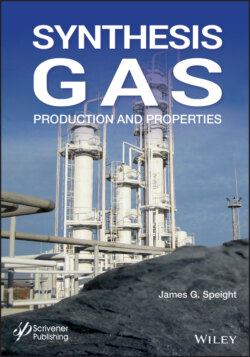Читать книгу Synthesis Gas - James Speight G., James G. Speight - Страница 58
2.6.1 Gaseous Products
ОглавлениеThe products from gasification may be of low, medium, or high heat-content (high-Btu) content as dictated by the process as well as by the ultimate use for the gas (Speight, 2008, 2011a, 2013). However, the products of gasification are varied insofar as the gas composition varies with the system employed (Speight, 2013). It is emphasized that the gas product must be first freed from any pollutants such as particulate matter and sulfur compounds before further use, particularly when the intended use is a water gas shift or methanation (Cusumano et al., 1978; Probstein and Hicks, 1990).
Product gases from fixed-bed versus fluidized-bed gasifier configurations vary significantly. Fixed-bed gasifiers are relatively easy to design and operate and are best suited for small to medium-scale applications with thermal requirements of up to several thermal megawatts (megawatts thermal, MWt). For large-scale applications, fixed-bed gasifiers may encounter problems with bridging of the feedstock (especially in the case of biomass feedstocks) and non-uniform bed temperatures. Bridging leads to uneven gas flow, while non-uniform bed temperature may lead to hot spots, ash formation, and slagging. Large-scale applications are also susceptible to temperature variations throughout the gasifier because of poor mixing in the reaction zone.
Pressurized gasification systems lend themselves to economical synthesis gas production and can also be more flexible in production turndown depending on the reactor design. Typically this is the case for both a pressurized bubbling reactor and a circulating fluidized-bed reactor, while the flexibility of an atmospheric fluidized-bed reactor is typically limited to narrower pressure and production ranges. Both designs are well suited for pressurized synthesis gas production. Pressurized designs require more costly reactors, but the downstream equipment (such as gas cleanup equipment, heat exchangers, synthesis gas reactors) will consist of fewer and less expensive components (Worley and Yale, 2012).
In the process, the feedstock undergoes three processes during the conversation to synthesis gas – the first two processes, pyrolysis and combustion, occur very rapidly. In pyrolysis, char is produced as the feedstock heats up and volatile products are released. In the combustion process, the volatile products and some of the char reacts with oxygen to produce secondary products (primarily carbon dioxide and carbon monoxide) and the heat required for subsequent gasification reactions. Finally, the char reacts with steam to produce hydrogen (H2) and carbon monoxide (CO).
Combustion:
Gasification:
At the gasifier temperature, the ash and other feedstock mineral matter liquefies and exits at the bottom of the gasifier as slag, a sand-like inert material that can be sold as a co-product to other industries (e.g., road building). The synthesis gas exits the gasifier at pressure and high temperature and must be cooled prior to the cleaning stage. Full-quench cooling, by which the synthesis gas is cooled by the direct injection of water, is more appropriate for hydrogen production. The procedure provides the necessary steam to facilitate the water gas shift reaction, in which carbon monoxide is converted to hydrogen and carbon dioxide in the presence of a catalyst:
Water Gas Shift Reaction:
This reaction maximizes the hydrogen content of the synthesis gas, which consists primarily of hydrogen and carbon dioxide at this stage. The synthesis gas is then scrubbed of particulate matter and sulfur is removed via physical absorption (Speight, 2008; Chadeesingh, 2011; Speight, 2013). The carbon dioxide is captured by physical absorption or a membrane and either vented or sequestered.
